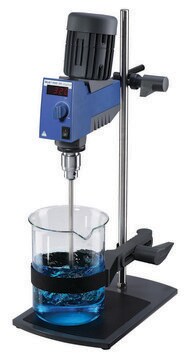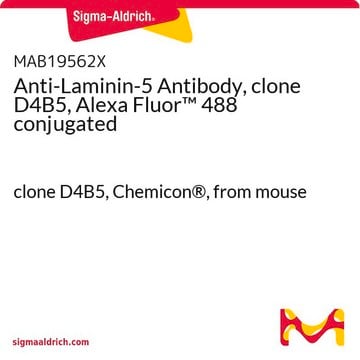AB3265
Anti-Actin γ Antibody
serum, Chemicon®
Zaloguj sięWyświetlanie cen organizacyjnych i kontraktowych
About This Item
Kod UNSPSC:
12352203
eCl@ss:
32160702
NACRES:
NA.41
Polecane produkty
pochodzenie biologiczne
sheep
Poziom jakości
forma przeciwciała
serum
rodzaj przeciwciała
primary antibodies
klon
polyclonal
reaktywność gatunkowa
mouse, human, rat
producent / nazwa handlowa
Chemicon®
metody
immunocytochemistry: suitable
immunohistochemistry: suitable
western blot: suitable
numer dostępu NCBI
numer dostępu UniProt
Warunki transportu
wet ice
docelowa modyfikacja potranslacyjna
unmodified
informacje o genach
human ... ACTG1(71)
Opis ogólny
Actin is a 43kDa highly conserved structural protein. There are three main actin isotypes (alpha,beta and gamma) which show >90% amino-acid (aa) homology between isotypes and >98% homology within members of a particular isotypic group. The majority of the isotype heterogeneity is located in the amino-terminal 30 aa. The different actin isotypes have been shown to behave very differently in vitro and in vivo. Recent studies describe differential subcellular localization of gamma-actin and isotype specific binding of actin associated proteins. {Pardo et al, 1983, Cell 32:1093-1103 & Otey, CA et al 1986 J Cell Biol 102:1726-1737, Bassell et al, 1998, J Neurosci 18:251-265 {available online}. Furthermore, there are at least six actin isoforms in vertebrates: cardiac alpha-actin and skeletal-alpha actin (expressed in striated muscle), vascular alpha-actin and enteric gamma-actin (expressed in smooth muscle), and cytoplasmic beta- and gamma-actins.{http://www.cbil.upenn.edu/MTIR/gammaActin_E-toc.html}
Specyficzność
Recognizes actin, gamma. Specificity for gamma actin determined by 2D gel electrophoresis.
Immunogen
Epitope: gamma
Synthetic peptide corresponding to the amino terminus of gamma actin {EEEIAALVIDNGSGGSG} conjugated to KLH.
Zastosowanie
Anti-Actin Antibody, γ is an antibody against Actin for use in IC, IH & WB.
Research Category
Cell Structure
Cell Structure
Research Sub Category
Cytoskeleton
Cytoskeleton
Western Blot: 1:500-1:2,000 or greater; non-specific bands can occur when primary antibody is overloaded. Blocking with purified milk proteins preferred over commerical concentrated milk solutions. Detects a 42-43kDa band. Specificity for gamma actin determined by 2D gel electrophoresis.
Immunocytochemistry: 1:500-1:2,000. Cultured cells fixed with PFA, then permeabilized with methanol.
Immunohistochemistry: 1:500-1:2,000. Tissues frozen and then fixed with PFA followed by Triton permeabilisation. 10% buffered formalin fixed tissues have also been used.
Optimal working dilutions must be determined by the end user.
Immunocytochemistry: 1:500-1:2,000. Cultured cells fixed with PFA, then permeabilized with methanol.
Immunohistochemistry: 1:500-1:2,000. Tissues frozen and then fixed with PFA followed by Triton permeabilisation. 10% buffered formalin fixed tissues have also been used.
Optimal working dilutions must be determined by the end user.
Opis wartości docelowych
42-43kDa
Postać fizyczna
Serum. Liquid, containing no preservatives.
Unpurified
Przechowywanie i stabilność
Maintain for 1 year at -20°C from date of shipment. Aliquot to avoid repeated freezing and thawing. For maximum recovery of product, centrifuge the original vial after thawing and prior to removing the cap.
Komentarz do analizy
Control
Smooth muscle
Smooth muscle
Inne uwagi
Concentration: Please refer to the Certificate of Analysis for the lot-specific concentration.
Informacje prawne
CHEMICON is a registered trademark of Merck KGaA, Darmstadt, Germany
Oświadczenie o zrzeczeniu się odpowiedzialności
Unless otherwise stated in our catalog or other company documentation accompanying the product(s), our products are intended for research use only and are not to be used for any other purpose, which includes but is not limited to, unauthorized commercial uses, in vitro diagnostic uses, ex vivo or in vivo therapeutic uses or any type of consumption or application to humans or animals.
This page may contain text that has been machine translated.
Not finding the right product?
Try our Narzędzie selektora produktów.
polecane
Kod klasy składowania
10 - Combustible liquids
Certyfikaty analizy (CoA)
Poszukaj Certyfikaty analizy (CoA), wpisując numer partii/serii produktów. Numery serii i partii można znaleźć na etykiecie produktu po słowach „seria” lub „partia”.
Masz już ten produkt?
Dokumenty związane z niedawno zakupionymi produktami zostały zamieszczone w Bibliotece dokumentów.
Zengdun Shi et al.
Laboratory investigation; a journal of technical methods and pathology, 97(12), 1412-1426 (2017-10-17)
Liver fibrosis, a model wound healing system, is characterized by excessive deposition of extracellular matrix (ECM) in the liver. Although many fibrogenic cell types may express ECM, the hepatic stellate cell (HSC) is currently considered to be the major effector.
Don C Rockey et al.
The American journal of pathology, 189(11), 2209-2220 (2019-09-03)
In the liver, smooth muscle α-actin (SM α-actin) is up-regulated in hepatic stellate cells (HSCs) as they transition to myofibroblasts during liver injury and the wound healing response. Whether SM α-actin has specific functional effects on cellular effectors of fibrosis
Chandrashekara Kyathanahalli et al.
Proceedings of the National Academy of Sciences of the United States of America, 112(45), 14090-14095 (2015-10-28)
We previously identified myometrial caspase-3 (CASP3) as a potential regulator of uterine quiescence. We also determined that during pregnancy, the functional activation of uterine CASP3 is likely governed by an integrated endoplasmic reticulum stress response (ERSR) and is consequently limited
S D Burton et al.
Neuroscience, 215, 1-16 (2012-05-01)
Neuroligins are a family of cell adhesion molecules critical in establishing proper central nervous system connectivity; disruption of neuroligin signaling in vivo precipitates a broad range of cognitive deficits. Despite considerable recent progress, the specific synaptic function of neuroligin-1 (NL1)
Zengdun Shi et al.
American journal of physiology. Gastrointestinal and liver physiology, 318(3), G504-G517 (2020-01-14)
Activation of hepatic stellate cells (HSCs), characterized by development of a robust actin cytoskeleton and expression of abundant extracellular matrix (ECM) proteins, such as type 1 collagen (COL.1), is a central cellular and molecular event in liver fibrosis. It has
Nasz zespół naukowców ma doświadczenie we wszystkich obszarach badań, w tym w naukach przyrodniczych, materiałoznawstwie, syntezie chemicznej, chromatografii, analityce i wielu innych dziedzinach.
Skontaktuj się z zespołem ds. pomocy technicznej





